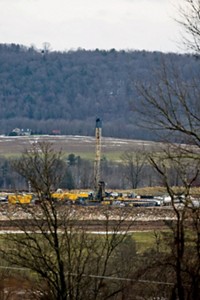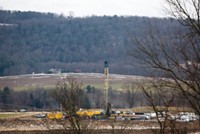Advertisement
Grab your lab coat. Let's get started
Welcome!
Welcome!
Create an account below to get 6 C&EN articles per month, receive newsletters and more - all free.
It seems this is your first time logging in online. Please enter the following information to continue.
As an ACS member you automatically get access to this site. All we need is few more details to create your reading experience.
Not you? Sign in with a different account.
Not you? Sign in with a different account.
ERROR 1
ERROR 1
ERROR 2
ERROR 2
ERROR 2
ERROR 2
ERROR 2
Password and Confirm password must match.
If you have an ACS member number, please enter it here so we can link this account to your membership. (optional)
ERROR 2
ACS values your privacy. By submitting your information, you are gaining access to C&EN and subscribing to our weekly newsletter. We use the information you provide to make your reading experience better, and we will never sell your data to third party members.
Environment
Thoughts On Fracking
May 18, 2015
| A version of this story appeared in
Volume 93, Issue 20
March 9, page 2: The sample indicated in the letter titled “Seaborg’s Plutonium Roots” should have been shown in micrograms (µg), not milligrams (mg).
I am pleased to see that C&EN is giving attention to the plethora of environmental and health problems associated with hydraulic fracturing, or fracking, technology (C&EN, March 16, page 8). I have a suggestion for government: Start regulating and actually enforcing real environmental oversight. I do understand the reluctance to do so. It would hurt campaign contributions and other perks from industry.
But if two things were to happen, perhaps we could feel better about fracking. First, full disclosure of the quality and quantity of everything that is injected into our environment should be required. All additives and their amounts plus the octanol/water partition ratios, LD50 values, biodegradabilities, and all other pertinent information must be cataloged before use. Second, a man-made nontoxic tracer must be added to the fracking fluid. Sulfur hexafluoride (SF6) is used extensively by the U.S. Geological Survey. However, a wide variety of other materials could be used such that each well has a specific and verifiable tracer. Any contamination of aquifers, individuals’ drinking water wells, rivers, and the like could then be proven, and industry would be liable. Additionally, methane leakage at each and every well must be monitored, because climate change is real.
Full disclosure, gas leakage monitoring, and verifiable fracking fluid tracers must become part of law—and sooner rather than later.
J. William Louda
Boca Raton, Fla.
Contrary to C&EN’s reporting, hydraulic fracturing has actually been widely used in both conventional and unconventional formations (page 13). I am also surprised to see that New Mexico was labeled as a “no fracking” state in the figure. The Permian Basin, a large oil- and natural-gas-producing area, is largely contained in the western part of Texas and the southeastern part of New Mexico. New Mexico is one of the U.S.’s biggest oil- and gas-producing states.
Leiming Li
Sugar Land, Texas




Join the conversation
Contact the reporter
Submit a Letter to the Editor for publication
Engage with us on Twitter